Argus Panoptes
Argus Panoptes (All-seeing; Ancient Greek: Ἄργος Πανόπτης) or Argos (Ancient Greek: Ἄργος) is a many-eyed giant in Greek mythology. The figure is known for having generated the saying "the eyes of Argus", as in to be "followed by the eyes of Argus", or "trailed by" them, or "watched by" them, etc. These terms are used to describe being subject to strict scrutiny in one's actions to an invasive, distressing degree. The monstrous entity has been either directly included or indirectly alluded to in a wide variety of works influenced by Greco-Roman thought.
Mythology
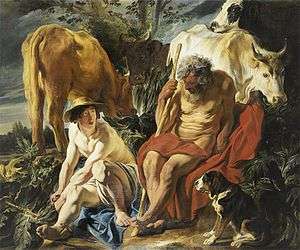
Argus Panoptes (Ἄργος Πανόπτης), guardian of the heifer-nymph Io and son of Arestor[1] and probably Mycene[2] (in other version son of Gaia[3]), was a primordial giant whose epithet Panoptes, "all-seeing", led to his being described with multiple, often one hundred, eyes. The epithet Panoptes was applied to the Titan of the Sun, Helios, and was taken up as an epithet by Zeus, Zeus Panoptes. "In a way," Walter Burkert observes, "the power and order of Argos the city are embodied in Argos the neatherd, lord of the herd and lord of the land, whose name itself is the name of the land."[4]
The epithet Panoptes, reflecting his mythic role, set by Hera as a very effective watchman of Io, was described in a fragment of a lost poem Aigimios, attributed to Hesiod:[5]
And set a watcher upon her, great and strong Argus, who with four eyes looks every way. And the goddess stirred in him unwearying strength: sleep never fell upon his eyes; but he kept sure watch always.

In the 5th century and later, Argus' wakeful alertness was explained for an increasingly literal culture as his having so many eyes that only a few of the eyes would sleep at a time: there were always eyes still awake. In the 2nd century AD Pausanias noted at Argos, in the temple of Zeus Larissaios, an archaic image of Zeus with a third eye in the center of his forehead, allegedly Priam's Zeus Herkeios purloined from Troy.[6]
Argus was Hera's servant. His great service to the Olympian pantheon was to slay the chthonic serpent-legged monster Echidna as she slept in her cave.[7] Hera's defining task for Argus was to guard the white heifer Io from Zeus, who was attracted to her, keeping her chained to the sacred olive tree at the Argive Heraion.[8] She charged him to "Tether this cow safely to an olive-tree at Nemea". Hera knew that the heifer was in reality Io, one of the many nymphs Zeus was coupling with to establish a new order. To free Io, Zeus had Argus slain by Hermes. The messenger of the Olympian gods, disguised as a shepherd, first put all of Argus' eyes asleep with spoken charms, then slew him by hitting him with a stone, the first stain of bloodshed among the new generation of gods.[9] After beheading Argus, Hermes acquired the epithet Argeiphontes or “Argus-slayer”.[3]
The sacrifice of Argus liberated Io and allowed her to wander the earth, although tormented by a gadfly sent by Hera, until she reached the Ionian Sea, named after her, from where she swam to Egypt and gave birth to a love child of Zeus, according to some versions of the myth.
According to Ovid, to commemorate her faithful watchman, Hera had the hundred eyes of Argus preserved forever, in a peacock's tail.[10][11]
The myth makes the closest connection of Argus, the neatherd, with the bull. In the Library of pseudo-Apollodorus, "Argos killed the bull that ravaged Arcadia, then clothed himself in its skin."[12]
Eponyms
Argus is referenced in the scientific names of at least six animals, each of which bears a pattern of eye spots: reptiles Cnemaspis argus, Eremias argus, Sibon argus, the Argus goanna Varanus panoptes and Sphaerodactylus argus;[13][14] the pheasant Argusianus argus; and the cowry Arestorides argus.
Gallery
Argus, Io and Hermes
 Io changed into a cow, Mercury cuts of Argus's head by Bernard Picart (1733)
Io changed into a cow, Mercury cuts of Argus's head by Bernard Picart (1733)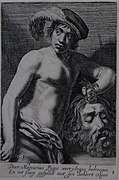 Mercurius and Argus by Jan van de Velde (1615-1641)
Mercurius and Argus by Jan van de Velde (1615-1641)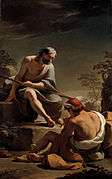 Mercury Lulling Argus to Sleep by Ubaldo Gandolfi (circa 1770–1775)
Mercury Lulling Argus to Sleep by Ubaldo Gandolfi (circa 1770–1775) Mercury About to Behead Argus by Ubaldo Gandolfi (circa 1770–1775)
Mercury About to Behead Argus by Ubaldo Gandolfi (circa 1770–1775) Mercury and Argus Alejandro de la Cruz (1773)
Mercury and Argus Alejandro de la Cruz (1773).jpg) Mercury and Argus by Petr Ivanov (1776)
Mercury and Argus by Petr Ivanov (1776)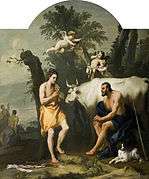 Argus Guarding Io Who Has Been Transformed into a White Heifer Jacopo Amigoni (18th century)
Argus Guarding Io Who Has Been Transformed into a White Heifer Jacopo Amigoni (18th century) Mercury about to Kill Argus Having Lulled Him to Sleep by Jacopo Amigoni (18th-century)
Mercury about to Kill Argus Having Lulled Him to Sleep by Jacopo Amigoni (18th-century)_Mercury_and_Argus.jpg) Merkur und Argus by Charles-André van Loo (18th century)
Merkur und Argus by Charles-André van Loo (18th century)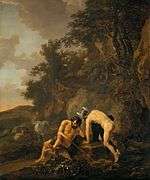 Landscape with Mercury and Argus by Jan Both (circa 1650)
Landscape with Mercury and Argus by Jan Both (circa 1650)- Mercury and Argus
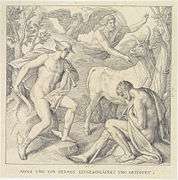 Argos wird von Hermes by Julius Schnorr von Carolsfeld (1794–1872)
Argos wird von Hermes by Julius Schnorr von Carolsfeld (1794–1872)- Mercury killing Argus by Nicolas Bertin (1700s)
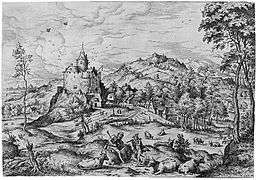 Die Landschaft mit Merkur und Argus by Hieronymus Cock (circa 1558)
Die Landschaft mit Merkur und Argus by Hieronymus Cock (circa 1558)- Mercury and Argus by Jacob Jordaens and Jan Wildens (c. early 1640s)
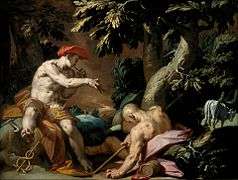 Mercury, Argus and Io by Abraham Bloemaert (circa 1592)
Mercury, Argus and Io by Abraham Bloemaert (circa 1592)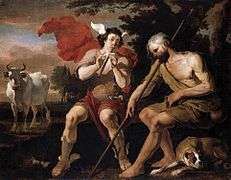 Mercury and Argos by Abraham Hondius (2nd half of 17th century)
Mercury and Argos by Abraham Hondius (2nd half of 17th century)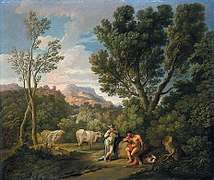 Mercury and Argus by Andrea Locatelli (1st half of 18th century)
Mercury and Argus by Andrea Locatelli (1st half of 18th century) Mercurius, Argus and Io by Cornelis Bisschop (17th century)
Mercurius, Argus and Io by Cornelis Bisschop (17th century)_-_Mercury_and_Argus_-_Google_Art_Project.jpg) Mercury and Argus by Follower of Claude Lorrain (17th century)
Mercury and Argus by Follower of Claude Lorrain (17th century)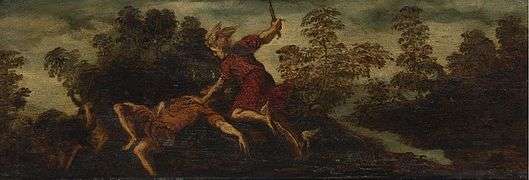 Mercury slaying Argus by Bonifazio Veronese
Mercury slaying Argus by Bonifazio Veronese.jpg) Mercury and Argus by René-Antoine Houasse (circa 1688)
Mercury and Argus by René-Antoine Houasse (circa 1688)_-_Mercury_wiegt_Argus_een_met_zijn_muziek.jpg) Mercury lulling Argus with his music by Circle of Cornelius van Poelenburgh (circa 1650)
Mercury lulling Argus with his music by Circle of Cornelius van Poelenburgh (circa 1650)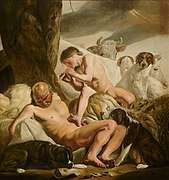 Argus, Mercury and Io by Jacob van Campen (circa 1630-1640)
Argus, Mercury and Io by Jacob van Campen (circa 1630-1640)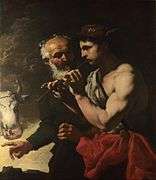 Mercury Piping to Argus by Johann Carl Loth (circa 1655-60)
Mercury Piping to Argus by Johann Carl Loth (circa 1655-60)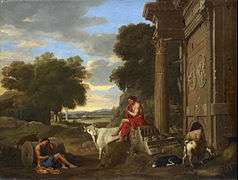 Mercury and Argus by Jean Lemaire (1625-1640)
Mercury and Argus by Jean Lemaire (1625-1640)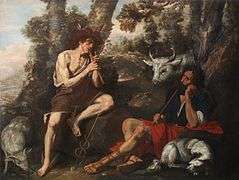 Mercurio addormenta Argo suonando il flauto
Mercurio addormenta Argo suonando il flauto.jpg) Mercury about to Kill Argus Having Lulled Him to Sleep by Jacopo Amigoni (1730-1732)
Mercury about to Kill Argus Having Lulled Him to Sleep by Jacopo Amigoni (1730-1732)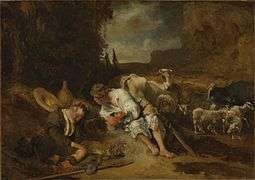 Mercury and Argus by Carel Fabritius (between circa 1645 and circa 1647)
Mercury and Argus by Carel Fabritius (between circa 1645 and circa 1647) Mercury and Argos by Peter Paul Rubens (1636-1638)
Mercury and Argos by Peter Paul Rubens (1636-1638)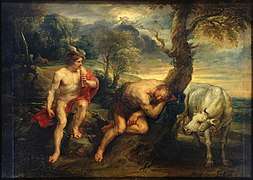 Mercury and Argus by Peter Paul Rubens (between 1635 and 1638)
Mercury and Argus by Peter Paul Rubens (between 1635 and 1638) Mercury and Argus by Pieter van Bloemen (early 18th century)
Mercury and Argus by Pieter van Bloemen (early 18th century)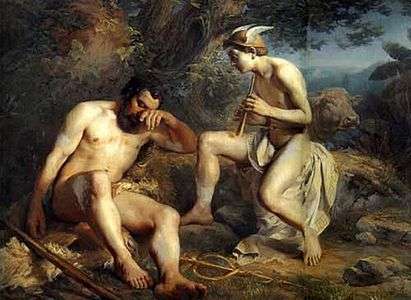 Hermes is putting Argus's eyes asleep to free Io by Nikolay Koshelev (1864)
Hermes is putting Argus's eyes asleep to free Io by Nikolay Koshelev (1864)- Mercury and Argus by Jan van Kessel the Elder (before 1679)
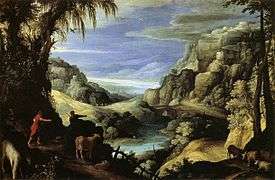 Landscape with Mercury and Argus by Paul Brill (1606)
Landscape with Mercury and Argus by Paul Brill (1606) Landscape with Mercury and Argus (circa 1570)
Landscape with Mercury and Argus (circa 1570) Mercury Killing Argus by Hendrik Goltzius (1589)
Mercury Killing Argus by Hendrik Goltzius (1589) Mercury Putting Argus to Sleep by Hendrik Goltzius (16th or 17th century)
Mercury Putting Argus to Sleep by Hendrik Goltzius (16th or 17th century)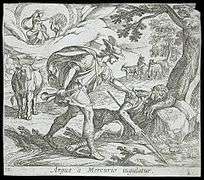 Mercury Killing Argus by Antonio Tempesta (1606)
Mercury Killing Argus by Antonio Tempesta (1606).jpg) Illustrations to the Metamorphoses of Ovid, Mercury Rescuing Io from Argus by Godfried Maes (1664 - 1700)
Illustrations to the Metamorphoses of Ovid, Mercury Rescuing Io from Argus by Godfried Maes (1664 - 1700)
Argus and Hera
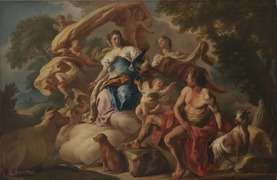 Juno (Hera) commits Io to Argus Panoptes by Francesco de Mura (1696–1784)
Juno (Hera) commits Io to Argus Panoptes by Francesco de Mura (1696–1784)
Notes
- Therefore called Arestorides (Pseudo-Apollodorus, Bibliotheca ii.1.3, Apollonius Rhodius i.112, Ovid Metamorphoses i.624).
- According to Pausanias, 2.16.3, Arestor was the consort of Mycene, the eponymous nymph of nearby Mycenae, while according to a scholiast on Homer's Odyssey, citing the Epic Cycle, Mycene and Arestor were the parents of Argus Panoptes, see Fowler, p. 236; Nostoi fr. 8* (West, pp. 160, 161) = Scholiast on the Odyssey 2.120.
- Roman, Luke; Roman, Monica (2010). Encyclopedia of Greek and Roman Mythology. Infobase Publishing. p. 80. ISBN 9781438126395.
- Walter Burkert, Homo Necans (1972) 1983:166-67.
- Hesiodic Aigimios, fragment 294, reproduced in Merkelbach and West 1967 and noted in Burkert 1983:167 note 28.
- Pausanias, 2.24.4 (noted by Burkert 1983:168 note 28).
- Homer, Iliad ii.783; Hesiod, Theogony, 295ff; Pseudo-Apollodorus, Bibliotheca ii.i.2).
- Pseudo-Apollodorus, Bibliotheke, 2.6.
- Hermes was tried, exonerated, and earned the epithet Argeiphontes, "killer of Argos".
- Ovid I, 625. The peacock is an Eastern bird, unknown to Greeks before the time of Alexander.
- Impelluso, Lucia; Zuffi, Stefano (2003). Eroi E Dei Dell'antichità. Getty Publications. p. 28. ISBN 0892367024. Retrieved 10 September 2015.
- Pseudo-Apollodorus, Bibliotheke, 2.4.
- Shea, G.M.; Cogger, H.G. (1998). "Comment On The Proposed Conservation Of The Names Hydrosaurus gouldii Gray, 1838 and Varanus panoptes Storr, 1980 (Reptilia, Squamata) By The Designation Of A Neotype For Hydrosaurus Gouldii". The Bulletin of Zoological Nomenclature. 55: 106–111. doi:10.5962/bhl.part.159.
- Beolens, Bo; Watkins, Michael; Grayson, Michael (2011). The Eponym Dictionary of Reptiles. Baltimore: Johns Hopkins University Press. xiii + 296 pp. ISBN 978-1-4214-0135-5. ("Argus", p. 11).
References
- Fowler, R. L. (2013), Early Greek Mythography: Volume 2: Commentary, Oxford University Press, 2013. ISBN 978-0198147411.
- Pausanias, Pausanias Description of Greece with an English Translation by W.H.S. Jones, Litt.D., and H.A. Ormerod, M.A., in 4 Volumes. Cambridge, MA, Harvard University Press; London, William Heinemann Ltd. 1918. Online version at the Perseus Digital Library.
- West, M. L., Greek Epic Fragments: From the Seventh to the Fifth Centuries BC. Edited and translated by Martin L. West. Loeb Classical Library No. 497. Cambridge, Massachusetts: Harvard University Press, 2003. Online version at Harvard University Press.
External links

- Warburg Institute Iconographic Database (ca 250 images of Io and Argus)

